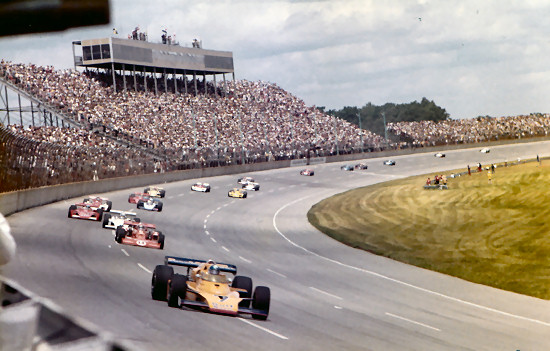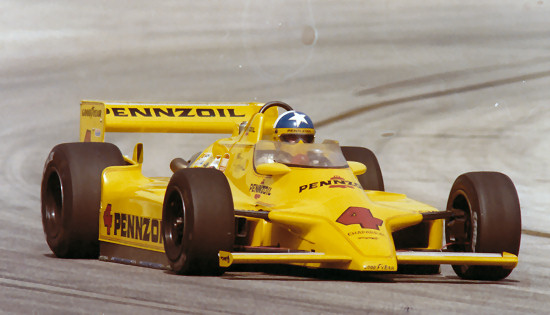The Way It Is/ Fittipaldi, Jones, Foyt & Rutherford on their favorite race carsby Gordon Kirby |
 This week's second of five installments discussing the favorite race cars of many of the world's top drivers of the last half century features Emerson Fittipaldi, Parnelli Jones, A.J. Foyt and Johnny Rutherford. We begin with two-time F1 World Champion and Indy 500 winner Fittipaldi.
This week's second of five installments discussing the favorite race cars of many of the world's top drivers of the last half century features Emerson Fittipaldi, Parnelli Jones, A.J. Foyt and Johnny Rutherford. We begin with two-time F1 World Champion and Indy 500 winner Fittipaldi.
"I had the pleasure of racing some beautiful and fast Penske Indy cars," Emerson observes. "I won two Indy 500s driving Marlboro Penskes and they were fantastic cars. I also won the World Championship in 1974 driving a beautiful and fast McLaren M23 Formula 1 car, but for me the Lotus 72 for sure is my favorite car. "The John Player Special Lotus 72 was not only my first World Championship car in 1972 but it was a car that taught me so much. I raced the same chassis for nearly four seasons and every Grand Prix we were improving and changing the car. I had the pleasure of working with a genius in Colin Chapman in developing the Lotus 72. That was an incredible car and every time I see that car it gives me a surge of emotion and great memories. "In my opinion, through all the history of Grand Prix racing the Lotus 72 is one of the nicest-looking cars ever and it was made even more beautiful when the Gold Leaf brand was changed to the John Player Special livery. The first time I saw it I fell in love with it. It was stunningly beautiful: a black car with elegant gold pin stripes, and it's considered by many people to be one of the most beautiful and iconic Grand Prix cars of all-time.  © Dan Boyd "But knowing Colin and his English sense of humor I said to him. 'You know Colin, there's only one thing missing from this car. It doesn't have four handles to make it look like a coffin!' "He laughed and laughed, but both of us knew how beautiful the car looked. The Lotus 72 was a beautiful car on its own because it was the right shape, one of the first wedge-shaped Formula 1 cars, but with the black paint and gold stripes it was even more beautiful. "And of course the Lotus 72 was also a beautiful car to drive. It was really well-balanced and Ronnie Peterson and I could drive those cars with the tail out in high-speed corners. Between 1970 and '73 between Jochen Rindt, Ronnie and myself we won 15 Grand Prix races with those cars and Jochen won the 1970 World Championship and I won the World Championship two years later. "The toughest year was 1971 when we changed from treaded tires to slicks. We had to be flexible and make a lot of changes to the set up and by the end of '71 we were back again, extremely strong like we had been at the end of 1970 when Jochen won the championship. "So the Lotus 72 played a very big role in Grand Prix racing history during those years and many, many racing fans around the world have told me that the John Player Special Lotus 72 is their favorite Formula 1 car. I agree wholeheartedly." Indy 500 winner, Trans-Am champion and Baja 1000 record holder, Parnelli Jones chooses without reservation the classic Watson-Offy roadster he drove in four successive Indy 500s from 1961-'64, winning the race in '63.  © Racemaker/Dave Knox "The car ran at Indianapolis for five years and not too many Indy cars run that competitively for so many years. Lloyd Ruby drove 'Calhoun' in 1960 and I drove it in 1961, '62, '63 and '64. I led a lot of laps at Indianapolis in 'Calhoun' and could've won in my rookie year, 1961, until I lost a cylinder. The next year I led again with 'Calhoun' but ran out of brakes before we finally won the 500 in 1963. So that car meant a lot to me. "The first year I ran at Indianapolis when you got sideways the experienced guys would tell you not to do that. They said if you have to start turning the car the other way you were going to spin it and hit the wall, and we saw Jack Turner do exactly that thing. "One time during practice in my rookie year I came out of turn four and got sideways. I corrected just a little bit and it was a miracle that I kept it out of the wall. That taught me that the next time the car did that I was going to be ahead of it. "I led the race for 27 laps in my rookie year and had a chance to win but we lost a cylinder. After the race I got a chance to do some tire testing for Firestone. I ran around 1,500 miles tire testing and by the end of the test the gearshift and everything else was falling apart. "But during those tire tests I learned how to slip the car and be ahead of it. I learned how to slip the car on purpose so I could come off the corners with the car running freer and keep my speed up, which was one of the reasons I had an edge with that car. In those days the tires were tall and skinny and the drivers were fat compared to today's young guys. "I get a chance to drive 'Calhoun' every once in a while at Indianapolis and it's like putting on an old glove. I gave that car it's name. One day I said, 'Let Calhoun have the ball.' And from then on, it took on that name. We put a lot of happy miles in that car."  © National Speed Sport News "I loved to run sprint cars on half-mile dirt tracks like Allentown, Pennsylvania and also Reading and Williams Grove in Pennsylvania, and Terre Haute, Indiana," A.J. says warmly. "I think my favorite car was a sprint car I bought from Elmer George [and Mari Hulman George] in 1964. I took the Offy out and put a Chevrolet in it. It handled real well and really was unbeatable. "Jud Larson drove it at New Bremen (Ohio) and won the race. It was the next day after I won Indy [in 64], and he said, if I won the 500, he was gonna drive the sprinter at New Bremen. And I said no, and I towed it over there to drive it. I think Jud was there in Paul Leffler's sprint car and he got out and came over and said, 'I told you I was gonna drive it.' So I let him drive it and he won the race." Like Mario Andretti and some others, three-time Indy 500 winner Johnny Rutherford has a variety of favorite cars "There are several cars you could call my favorites," Johnny says. "I won two Indy 500s with McLaren in 1974 and '76 driving those beautiful M16C-Offies and one more Indy 500 in 1980 with Jim Hall's Chaparral 2K and those are definitely among my favorite cars. The M16 McLaren and the Chaparral were two special race cars for me, but there were also some sprint cars I drove that I remember very fondly. "I won the USAC sprint car championship in 1965 driving Wally Meskowski's car which was a great car. Meskowski had a tremendous record in sprint cars. Foyt drove Meskowski's sprint car and so did Chuck Hulse and Roger McCluskey and all of them had success in that car. "It had some characteristics that were unlike any other car I had driven. It handled really well and allowed me to perform well. It was the first sprint car I drove that had as much side bite as it had forward bite and I had never felt a car that could do that. It was incredible, a great race car.  © Racemaker/Dennis Torres "The first year I drove for McLaren was 1973 and we went to the Speedway to test for the first time in January. The weather was decent. It was cold but it wasn't a problem, so we started testing and the car pushed like a pig. It just understeered terribly. We finally got it a little better but it still understeered and that's the last thing you want. If you can handle it, you want the car to be neutral. You don't want to create any drag from the front tires. "So we got it as good as we could and everyone went home and we came back in May and started testing and they had solved the problem. It was neutral, the way I like a car, and with Roger Bailey's big boost Offy making as much as 1,200 horsepower it was something! "I had never been able to flat foot it around the Indianapolis Motor Speedway. In that era of USAC, Indy cars had rear wings that were massive across the whole width of the car and you had to compensate for that with the front wings and trim the car just right. We had the horsepower to overcome the drag of the big, picnic table rear wing and it all came together. We set a new track record at more than 198 mph and it was a treat to drive. "Of course, the Chaparral 2K ushered in a whole new era. It was the first real ground effects Indy car and it put whole new demands on the driver with the lateral g-forces it created. It was fast, very fast and took a little acclimatizing to get used to. It's interesting that the basic concept of the Chaparral remains unchanged through today. You used the rear wing as a trim tab and the front wing to balance it. "The first time I tested the Chaparral was on the one-mile oval at Phoenix and we had some problems the first day. Al Unser drove the car the previous year when it was new and he won the last race of the '79 season at Phoenix. Jim Hall hired me to drive for him in 1980 and we went testing with the car set up just like Al had won with and I couldn't drive it. It was plenty scary.  © Racemaker/Dennis Torres "The only time I had to lift was going into turn one to transfer weight to the right front to stop it from understeering or pushing. That was the first time I ever had a race car that made enough lateral g to make me grunt. It would absolutely make me grunt as it turned into the corner and I had never experienced that before. That was a fantastic car and a pleasure to drive, and of course, we won the 500 and the championship with the Chaparral in 1980." Next week a brace of recent Indy 500 winners and champions including Michael Andretti, Bobby Rahal, Juan Pablo Montoya, Jacques Villeneuve and Paul Tracy will regale us with more stories about their favorite cars. |
|
Auto Racing ~ Gordon Kirby
Copyright ~ All Rights Reserved |
